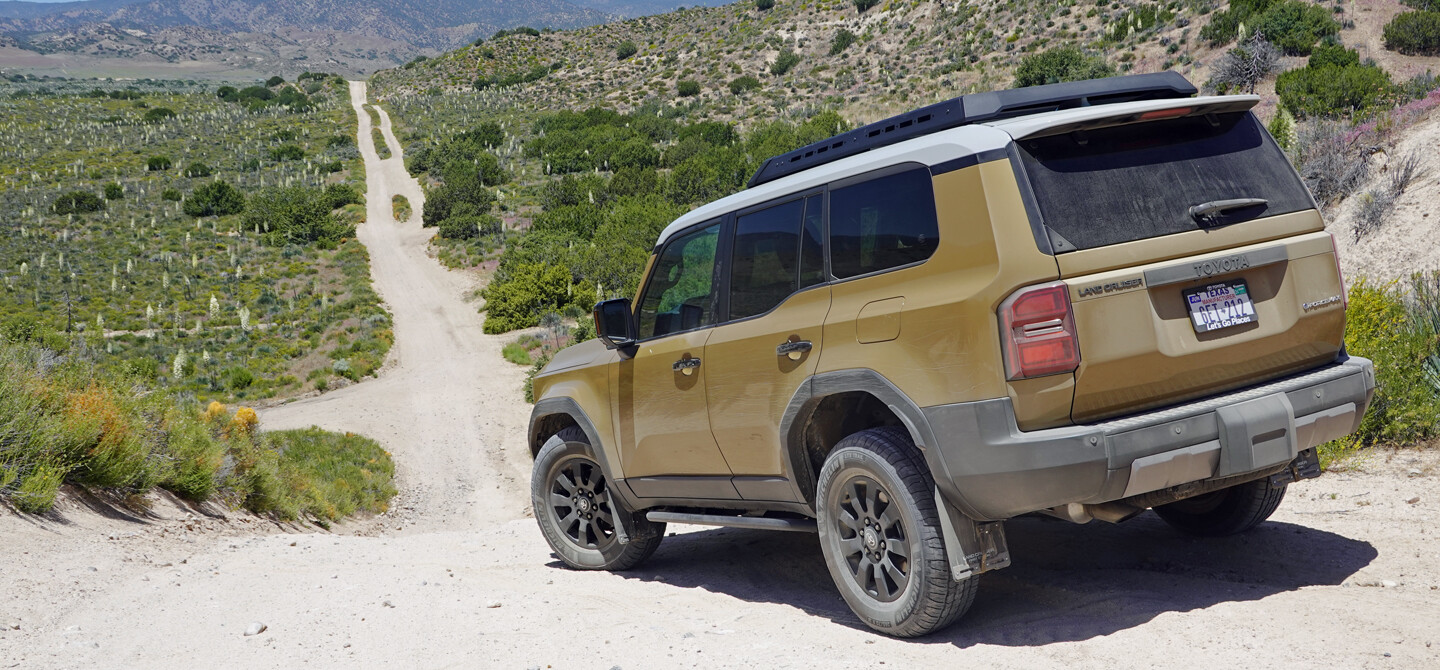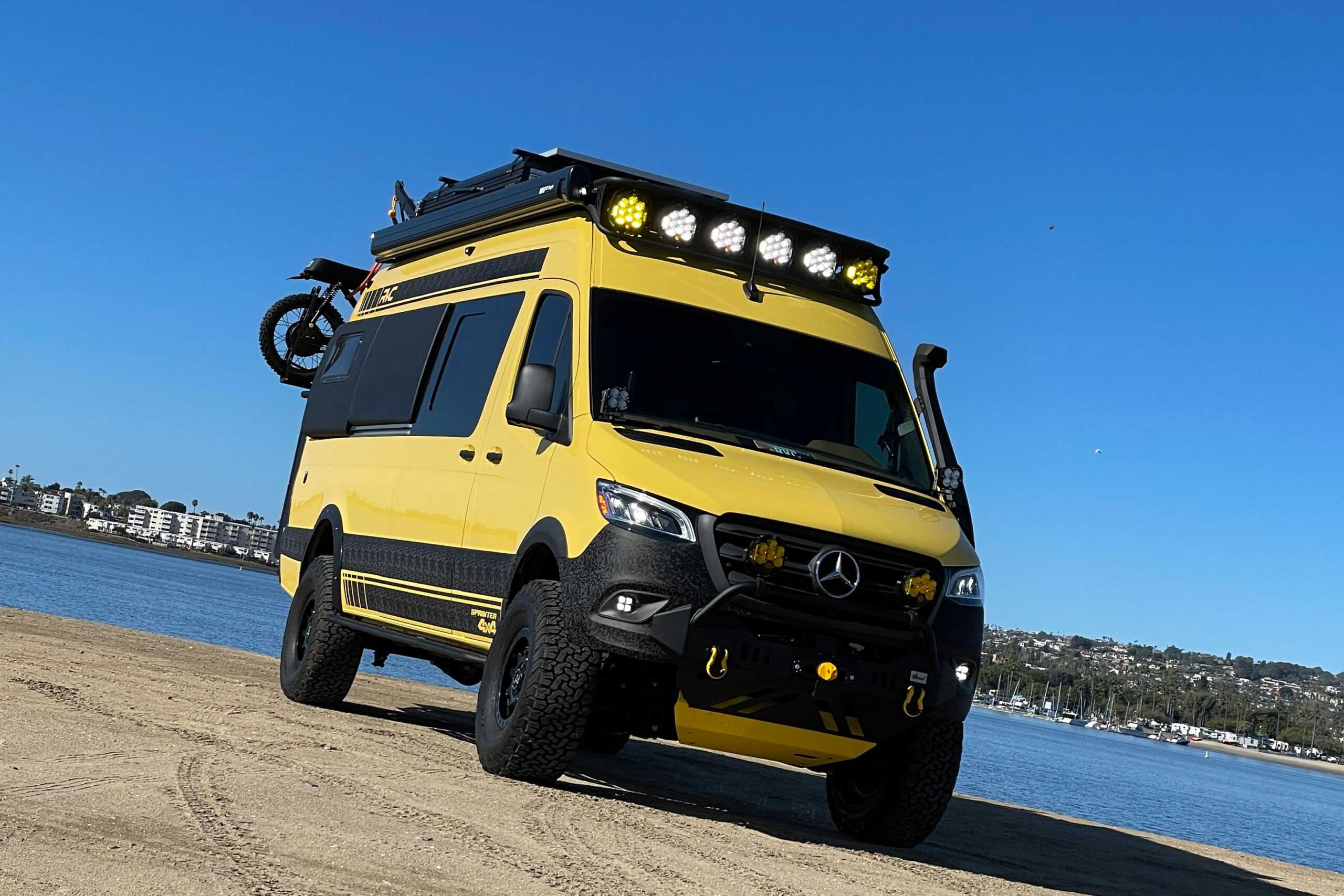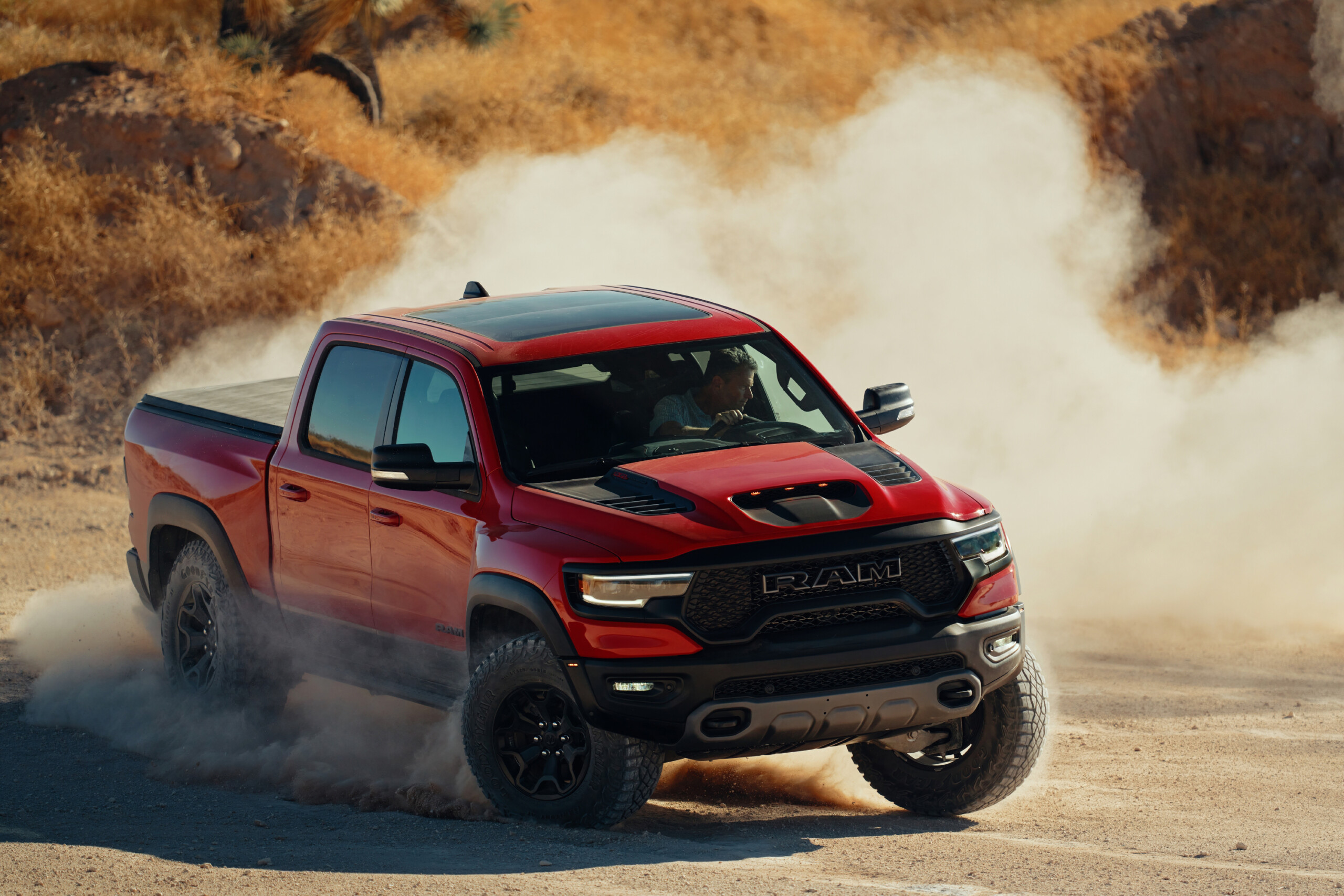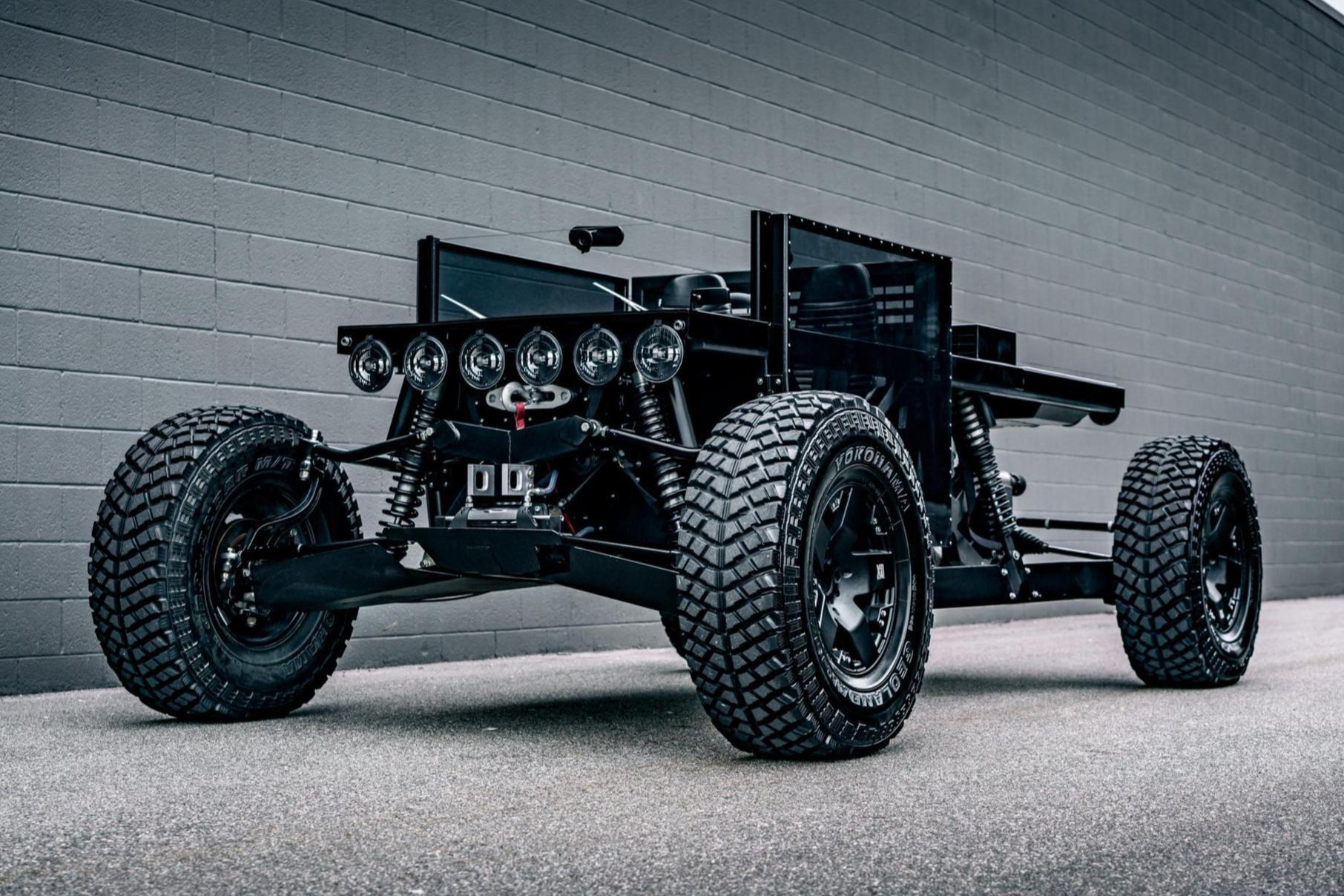When it comes to nameplates on four-wheel-drive vehicles, few are as iconic as the Toyota Land Cruiser. The Land Cruiser has been a key player in the four-wheeling scene since the very first FJ40s rolled onto North American soil back in 1960. As each new generation has evolved, the one thing that hasn’t changed is Toyota’s commitment to capability. Even the previous-generation Land Cruiser that departed in 2021 — a big, bulky, and expensive luxury machine — was endowed with serious trail chops and robustness. Toyota wisely brought a new Land Cruiser back into its lineup for 2024. It’s trail-ready right off the showroom floor, and it carries a much more reasonable price. It also exudes a bit of retro charm for the true Land Cruiser fans. Here are our impressions of the 2024 Toyota Land Cruiser.
The 2024 Toyota Land Cruiser Uses Toyota’s TNGA-F Global Truck Platform
The new Land Cruiser is technically an FJ250, known globally as the Prado. The larger and more luxurious FJ300 (the “big” Land Cruiser) comes to the USA only as a Lexus — the LX600. Interestingly, both share the same TNGA-F global truck platform underneath the metal, like the 4Runner, Tacoma, Tundra, and Lexus GX 550. The fully boxed frame system is simply tweaked and modified to suit each vehicle. But the one vehicle that the Land Cruiser shares most with is the GX 550. You can think of the GX as a more powerful and robust Land Cruiser. And we’ll get into some of the differences later.

Up front, the Land Cruiser has an independent front suspension with coil springs. The front differential is the same open 8.0-inch unit found on the Tacoma.
Three Land Cruiser Models For 2024
For the 2024 model year, the Land Cruiser is available in three trims. There’s the base 1958 model with round headlights, the mid-grade model, dubbed simply “Land Cruiser” with conventional rectangle lights and a solid list of optional equipment, and the First Edition — the fully loaded model with retro round lights. One key feature that comes standard on the First Edition is the electronic disconnecting front sway bar, which is the prime reason we decided to borrow a $74,950 MSRP model for testing.
How does the new Land Cruiser perform compared to previous models? We spent some time on- and off-road in Southern California to find out.

Out back, the Land Cruiser has a multilink suspension with coil springs. The rear solid axle has a 9.5-inch ring gear and an electronic locking differential.
The Hardware
The 2024 Land Cruiser has a 112.2-inch wheelbase — nearly the same as the previous-generation Land Cruiser. The difference is that the new 2024 model weighs approximately 800 pounds less than the old one at 5,038 pounds versus 5,815 pounds.
A double-wishbone suspension with coil springs resides up front. The front differential is the same open 8.0-inch unit found on the Tacoma. The push-button electronic front sway bar disconnect system is the same one used in some Tacoma models. In the rear, the Land Cruiser uses a multilink suspension with coil springs. The rear solid axle has a 9.5-inch ring gear with electronic locking differential. A transfer case with a 2.57:1 low range splits the torque. The suspension provides room for 265/70R18 Michelin LTX Trail tires. These have a mild tread, but do offer a thick sidewall, making them somewhat dirt-friendly.
Hybrid-Powered, 6,000 Pounds Towing Capacity
The new Land Cruiser strays a bit from past generations when it comes to the powertrain. Instead of a V8 or I6, it utilizes a turbocharged 2.4-liter four-cylinder hybrid system paired to an eight-speed automatic. The system cranks out 326 horsepower at 6,000 rpm and 465 pound-feet of torque at 1,700 rpm. Impressive numbers to be sure.
And when it comes to hauling cargo, the Land Cruiser has a payload capacity of 1,100 pounds and can tow 6,000 pounds. The Lexus GX is nearly identical in size but can tow 9,000 pounds. Why such a big difference? Well, the GX uses a more powerful twin-turbo V6 and pairs it to the Tundra’s 10-speed transmission. It also uses the Tundra’s front axle. So, in mechanical terms, the GX is closer to the full-size Tundra, while the Land Cruiser is most like the midsize Tacoma.

The Land Cruiser’s tailgate has flip-up glass, which makes loading and unloading of smaller items quick and easy.
Interior And Ride
It’s easy to see the Land Cruiser lineage in the design of the new 2024 model. Squint, and from just about any angle you can see some FJ60 in the style. To our eyes, this is a far more attractive look than the previous model.
On the inside, Toyota has done a great job putting the focus where it should be — on functionality. All the buttons and switches that control the drivetrain surround the gearshift and are within easy reach of the driver. This is a far better setup than some SUVs where you need to go deep into touchscreen menus to perform a simple function. But that doesn’t mean the new Land Cruiser isn’t tech-forward. Our First Edition came standard with the large 12.3-inch infotainment touchscreen. And yet, Toyota keeps the climate control functionality with real buttons. Someone at Toyota certainly understands the value of knobs and buttons, and we appreciate that.
The old Land Cruiser had an incredibly smooth ride on- or off-road. And while this new one doesn’t quite match up, it’s still plenty comfy. The chassis feels robust and up to the task. Pound the Land Cruiser through a field of LA’s worst potholes and it remains composed.
Hybrid Powertrain Hits and Misses
The hybrid powertrain is torquey, and it helps the SUV move out quickly. Acceleration is certainly good, but do we miss the old V8? Well, yes, we do. There’s nothing like a V8 in terms of power delivery. Toyota has made the throttle tip-in a little too aggressive here. It’s a trick that automakers use to make vehicles feel a little peppier than they are. And because of that, the power delivery from a stop can sometimes be too abrupt. But the thing that’s most annoying about this hybrid Land Cruiser is the drag from the regenerative brake system. Ease off the throttle and the system kicks in to act like a generator and charge the battery. The effect is like someone riding the brakes for you instead of letting you coast smoothly to a stop. And the level of regeneration is a little too much. The driver should be allowed to adjust the level, just like you can on some fully electrified vehicles.

On fire roads, the Land Cruiser was happy trundling along at 35 to 40 mph thanks to its relatively soft suspension.
Freeway Driving Is Pleasant, But Full Power Can Be Limited
On the freeway, the Land Cruiser is a pleasant machine. The ride is smooth and yet it handles well when the road twists. It feels way more athletic and buttoned-down than the previous-generation heavyweight Land Cruiser. But to be fair, the previous Land Cruiser had a wonderful command-style driving position that this new one just doesn’t have. That’s not a deal-breaker, but it’s a feature we’ll miss.
The old Land Cruiser had a great, torque-rich V8. And this new powertrain has even more grunt down low. But there’s a catch. At 70 mph, the engine is only revving at 1,700 rpm thanks to the gearing. The electric boost from the hybrid system works with the four-cylinder engine to maintain that speed on freeway grades too — if the battery still has a charge. If it’s depleted, the torque drop-off from the low-revving four-cylinder is noticeable, and it requires the transmission to downshift to maintain speed. If the mountain pass you are climbing is uphill without any downhill sections for the battery to charge, you’ll be stuck without the full horsepower and torque of this powertrain.
On-Road Fuel Economy Results
The old Land Cruiser was known for its poor fuel economy. In fact, we routinely saw 14 to 15 mpg in mixed-use driving in those test vehicles. On paper, this new one is way more efficient. It’s rated by the EPA at 22 mpg city and 25 mpg on the highway. We saw an average of just 17.6 mpg. This dramatically lower number can be blamed (at least partially) on our lead-footed driving style on- and off-road.
Interior Observations
Toyota may have taken the price and luxury down a few notches on this Land Cruiser, but the interior still has plenty of softly padded surfaces. The Land Cruiser is a great place to spend time. And that goes for the rear seat too, which reclines and allowed our six-foot frame plenty of knee clearance to the front seatbacks. What’s the one downside of this Land Cruiser interior over the previous generation? No third-row seat. Blame it on the battery pack. It lives under the cargo floor, so the raised floor does eat up some cargo space. If you want Land Cruiser 4WD capability and a third row of seats, the more expensive Lexus GX offers the option.
Respectable Suspension Flex With The Sway Bar Disconnected
One of the greatest off-road strengths of the old Land Cruiser 200 was that it could be driven from the paved highway directly onto a mild dirt trail without touching the transfer case or pressing a button. The suspension, torque, and traction all worked so well that it had tremendous baseline capability. That’s because the old Land Cruiser used a Kinetic Dynamic Suspension System (KDSS) to loosen the sway bars on demand and instantly boost trail traction without the driver lifting a finger. The Lexus GX 550 has KDSS as optional equipment.
The new Land Cruiser maintains those skills but requires a little more driver involvement. If you run out of traction in 4-Hi at speeds below 20 mph, you can unlock the front sway bar for extra traction. The Land Cruiser is fairly low-slung for an off-roader but it has an approach angle of 32 degrees and a departure angle of 17 degrees. Climb underneath and you’ll have about nine inches of clearance under the front diff.
Nasty Moguls And The Hill Climb Test
Thanks to the disconnected sway bar, the ride off-road was nice and smooth. And though the approach and departure angles look minimal, we were able to get the Land Cruiser through some fairly difficult terrain. The suspension flex through some nasty moguls was impressive. Engage Rock Crawl mode and the rear axle locks automatically. In this type of terrain in 4-Lo, the Land Cruiser works surprisingly well and was able to tackle some serious spots after we did a few clearance pre-checks. One issue we had was the backup camera. Its fisheye-type lens made it difficult to judge the distance to rocks or trees as we were reversing.
On our hill climb test, the Cruiser could not crest the top of the hill with the rear differential unlocked. It clawed for traction, but this was one point on the trail where we really needed more aggressive tires. Instead, we had to back down the slippery slope and try again. This time, with the rear axle locked, the Land Cruiser made the climb with no problem while traveling around 5 mph.

With the rear locker engaged and street tire pressure, the Land Cruiser effortlessly climbed our loose-surface hill climb.
Sandy Wash And Fire Roads
In the dry, sandy wash, the Land Cruiser could handle the terrain in 4-Hi with little drama. There was only an occasional intrusion from the traction and stability control systems. Once we clicked over to Sand mode, we were able to slide the Land Cruiser around a bit. But here’s the thing: It’s hard to be a hooligan in this truck. The hybrid powertrain just isn’t all that fun in this terrain. The responses are somewhat soggy, and the chassis doesn’t feel nimble. This is probably not the rig we’d choose for a weekend playing in the dunes.
On fire roads, the Toyota Land Cruiser was happy trundling along at 35 to 40 mph thanks to its relatively soft suspension. But, once you dial the speed up beyond the Toyota’s comfort zone, you can feel the limits of the dampers, resulting in the front end crashing down hard on the larger bumps. But keep the speed down, and the Land Cruiser is happy. We think that the Land Cruiser with a TRD Pro-type suspension could be great on this kind of terrain.

The Land Cruiser’s suspension flex allowed the tires to stay in contact with terra firma most of the time.
The Bottom Line
Many folks purchased the old Land Cruiser for its roominess. Without the third-row seat option, some might not consider the new Land Cruiser. The 2025 4Runner, which shares most of the mechanicals with the Land Cruiser, can be optioned with a non-hybrid powertrain. This would be a great option for the Land Cruiser — especially if it could reclaim some space that’s lost from the hybrid’s battery box. Additionally, the Land Cruiser would be more capable if it could be optioned with the 4Runner’s TRD Pro suspension and 33-inch tires. Perhaps some, or all, of these options will become available down the line. For the most part, we dig the new Land Cruiser’s design, and the performance is solid on both street and trail just like a Land Cruiser should be. Stay tuned for more Land Cruiser news on offroadxtreme.com





















